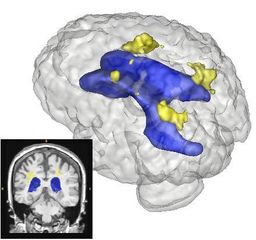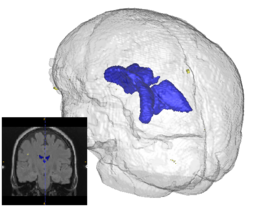Difference between revisions of "Projects:LesionSegmentation"
| Line 4: | Line 4: | ||
= Lesion Segmentation = | = Lesion Segmentation = | ||
| − | Quantification, analysis and display of brain pathology such as white matter lesions as observed in MRI is important for diagnosis, monitoring of disease progression, improved understanding of pathological processes and for developing new therapies. | + | Quantification, analysis and display of brain pathology such as white matter lesions as observed in MRI is important for diagnosis, monitoring of disease progression, improved understanding of pathological processes and for developing new therapies. Utah Center for Neuroimage Analysis develops new methodology for extraction of brain lesions from volumetric MRI scans and for characterization of lesion patterns over time. The images show white matter lesions (yellow) displayed with ventricles (blue) and transparent brain surface in a patient with an autoimmune disease (lupus). Lesions in white matter and possible correlations with cognitive deficits are also studied in patients with multiple sclerosis (MS), chronic depression, Alzheimer’s disease (AD) and in older persons. |
{| | {| | ||
| − | |[[Image:prastawa-lupus-demo001.png|thumb|256px|Segmentation of a lupus case with large lesions]] | + | |[[Image:prastawa-lupus-demo001.png|thumb|256px|Segmentation of a lupus case with large lesions.]] |
| − | |[[Image:prastawa-lupus-case001-3T.png|thumb|256px|Segmentation of a 3T lupus case with small lesions]] | + | |[[Image:prastawa-lupus-case001-3T.png|thumb|256px|Segmentation of a 3T lupus case with small lesions.]] |
|- | |- | ||
|} | |} | ||
| + | |||
| + | In addition to the identification of the location and shape of lesions in 3D, we are interested in analyzing the longitudinal series of brain MRI showing lesions. For this purpose, we have developed a method for estimating a model for lesion formation. The model that we use is an approximation using a reaction-diffusion process that is based on expected diffusion properties (as observed through DTI). | ||
| + | |||
| + | [[Image:prastawa-lesionest.png|An example of the lesion model formation estimation result. Starting from an initial guess of the reaction-diffusion process, the method estimates a model that best fits the observed data.]] | ||
= Publications = | = Publications = | ||
Revision as of 23:04, 9 December 2008
Home < Projects:LesionSegmentationBack to Utah 2 Algorithms
Lesion Segmentation
Quantification, analysis and display of brain pathology such as white matter lesions as observed in MRI is important for diagnosis, monitoring of disease progression, improved understanding of pathological processes and for developing new therapies. Utah Center for Neuroimage Analysis develops new methodology for extraction of brain lesions from volumetric MRI scans and for characterization of lesion patterns over time. The images show white matter lesions (yellow) displayed with ventricles (blue) and transparent brain surface in a patient with an autoimmune disease (lupus). Lesions in white matter and possible correlations with cognitive deficits are also studied in patients with multiple sclerosis (MS), chronic depression, Alzheimer’s disease (AD) and in older persons.
In addition to the identification of the location and shape of lesions in 3D, we are interested in analyzing the longitudinal series of brain MRI showing lesions. For this purpose, we have developed a method for estimating a model for lesion formation. The model that we use is an approximation using a reaction-diffusion process that is based on expected diffusion properties (as observed through DTI).
Publications
- Marcel Prastawa and Guido Gerig. Brain Lesion Segmentation through Physical Model Estimation. International Symposium on Visual Computing (ISVC) 2008. Lecture Notes in Computer Science (LNCS) 5358, Pages 562-571.
- Marcel Prastawa and Guido Gerig. Automatic MS Lesion Segmentation by Outlier Detection and Information Theoretic Region Partitioning. 3D Segmentation in the Clinic: A Grand Challenge II Workshop at Medical Image Computing and Computer Assisted Intervention (MICCAI) 2008. Insight Journal.
Key Investigators
- Utah Algorithms: Marcel Prastawa, Guido Gerig
- Clinical Collaborators
- MIND: Jeremy Bockholt, Mark Scully


